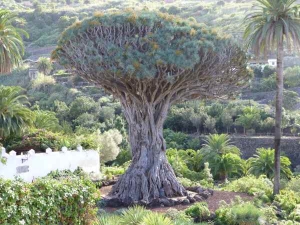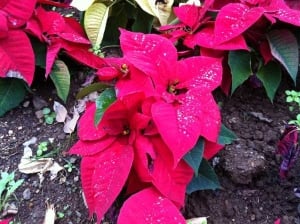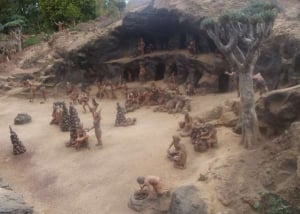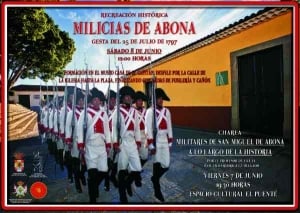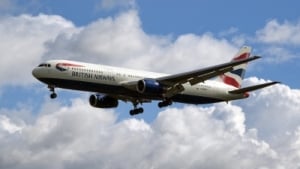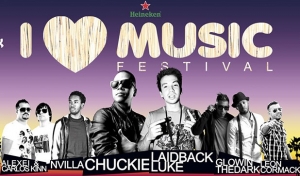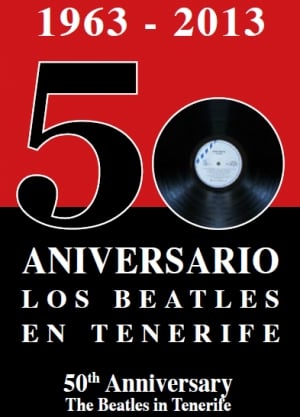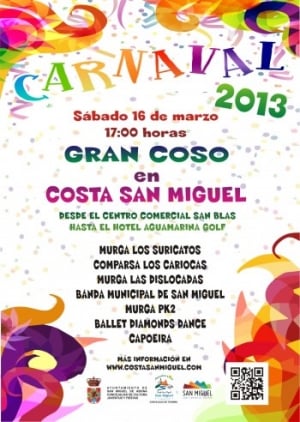
This article was by written Peter Allan
Peter fist visited Tenerife in 1982 staying in Puerto de la Cruz, and is now a habitual visitor to the island having become fascinated by its diversity, spending in excess of 8 weeks a year there. He has travelled all around the island staying in the lesser known resorts and towns, and has a particular interest in the history of Tenerife.
The Dragon Tree of Tenerife
The ‘Dracaena Draco’ to give it its proper name, is a native species to the Canary Islands, and is used as an official plant symbol of Tenerife.
The Dragon tree get its name from the red sap the tree produces, and is known as dragon’s blood. This red resin was used in ancient times as a dye, used in medication and wound healing, as well as warding off evil spirits.
The sap was also believed to be cure leprosy and was for time exported to Italy to stain violins and marble. In medieval times this red sap was claimed by some encyclopaedias to literally be the blood from dragons that had been slain in combat.
The most famous and the oldest dragon tree on Tenerife is located in the town of Icod de los Vinos on the islands northern side. The tree is believed to have been used by the native Guanche people as a place to hold important meetings.
This tree is reputedly over 1000 years old and is known as El Drago Milenario (The Thousand Year Old Dragon), although these claims are unsubstantiated as the trees are difficult to age; this mighty tree stands 22m high with a diameter of 22m.
In 1993 a road that ran a few meters from the tree was rerouted, and the tree now stands protected in its own park setting. The city council has tried twice to have to tree listed as a UNESCO World Heritage Site in 2002 and 2011.
The trees species are a remnant from the Tertiary period and have survived the ice age where the only places warm enough for them to grow were the Canary Islands, Cape Verde Islands and Madera.
Dragon Trees are actually classed as monocots, so they are not real trees at all, but in fact belong to the same family as asparagus.
Poinsettia the Christmas Weed
Along the rural roads of Tenerife you will find huge stands of Poinsettia plants. These plants are normally associated with winter and the Christmas period to north Europeans, so it can be quite surprising to find it grows in abundance on Tenerife.
The plant is originally from Mexico and can grow to heights of over 2m, with bright red leaves that look like petals and small yellow flowers. The plants proper botanical name is ‘Euphorbia pulcherrima’, but its popular name of Poinsettia is derived from the first ambassador of the USA to Mexico, Joel Robert Poinsett, who brought back plants from Mexican wilderness in 1828.
Although the leaves, which are normally mistaken for petals are famously red, they can bloom in different hues such as white, pink and yellow.
The Poinsettia plant has been reported as highly toxic, but this is a misconception. This plant is a member of the Spurge family, and while some spurge plants are toxic, the poinsettia’s toxicity is mild, and the average person would have to eat 500 to 700 leaves to cause a serious problem. The plants are classified as non-poisonous.
They do contain a compound that is similar to latex rubber however, so if you have a latex allergy you should be careful around poinsettia plants, as plant is part of the same family as natural latex rubber that is cultivated from the Brazilian rubber tree.
These plants were also cultivated by the Aztecs who made medicine from the milky sap and used the leaves to make dye.
So how did the poinsettia become associated with Christmas? Legend tells of a Mexican girl who could not afford a gift to Jesus on Christmas Eve, so she offered some weeds picked from the road side. She then placed these weeds around the manger in the nativity scene in the church. These weeds blossomed into beautiful red flowers and the manger was soon surrounded by star shaped flowers.
Bird of Paradise Flower
Many exotic plants have been introduced into Tenerife from all over the world including the iconic Bird of Paradise or Strelitzia flower, which has become a national symbol of Tenerife.
It is known as the Bird of Paradise or Crane Flower due to its resemblance to the birds head and beak; the flower heads are formed of bright yellow and orange, purple and blue.
Its proper name is ‘Strelitzia Reginae’, named after Queen Charlotte, Duchy of Mecklenburg-Strelitz, who was also the wife of King George III of England.
The plant was introduced to Europe at Kew Gardens in London in 1773 from South Africa, and has since been introduced to many countries around the world; it is also the official flower of the City of Los Angeles in the USA.
The plant is used as a bedding plant in the parks and hotel gardens of Tenerife due to its low maintenance and easy growing needing little water.
Tenerife Historical Calendar
Historical Events of Tenerife
3000BC –AD1500
There is archaeological evidence from skulls found suggest that the island was inhabited by Cro Magnon Man.
1100BC
It is believed that Carthaginians and Phoenicians visited the Canary Islands.
1312
Lanzarotto Malocello the Genoese explorer occupies Lazarotte and names the islands after him self.
1340
Ships from Spain and Portugal sent to investigate find the islands are inhabited by the Guanches, a people still living in the Stone Age.
1401
Jean de Bethancourt lands on Lazarote beginning the Spanish conquest of the Canary Islands.
1478
Gran Canaria is attacked by Juan Rejon, but the Guanches resist the occupation for five years.
1483
The first Governor of the Canary Islands, Pedro de Viera, is appointed.
1492
Christopher Columbus visit the Canary Islands for the first time and allegedly witnesses Mount Teide erupting.
1494
Tenerife is the last of the Canary Islands to be conquered by the Spanish.
16th and 17th Centuries
The Spanish continue to colonise the Canary Islands and a thriving economy is established by the settlers aided by the slave trade.
1657
The Royal Navy under the command of Admiral Blake destroys a Spanish treasure fleet off the coast of Tenerife in the Battle of Santa Cruz de Tenerife 1657.
1726
A group of 20 Canary Island families emigrated to South America and founded the city of Montevideo.
1706
Garachico, the main port of Tenerife at the time is destroyed by the Trevejo Volcano.
1797
Vice Admiral Nelson fails in an attempt to capture Tenerife at the Battle of Santa Cruz, also losing his right arm during the attempt.
1852
The Canary Islands are declared a free trade zone by Queen Isabella II.
End of 19th Century
The main export of the Canary Islands, Sugar Cane, is replaced by Bananas as the number one export.
1927
The Canary Islands are divided into two provinces with Santa Cruz de Tenerife named as the capital of the western province and Las Palmas de Gran Canaria the capital of the eastern province.
1936
The military coup which leads to the Spanish civil war is plotted in Tenerife by General Franco.
1982
Spain grants regional constitution to the Canary Islands.
1986
Special status is within the EU is granted to the Canary Islands.
2002
The Canary Islands adopt the Euro as currency.
Historical Re-Enactment of 1797
This weekend there is a re-enactment of the military action of 1797 when British and Spanish forces fought over the island of Tenerife. The then Vice Admiral Nelson, with a squadron of Royal navy ships and approx. 3000 men attempted to capture Santa Cruz de Tenerife.
Nelson failed and also lost his right arm in the process. This battle is still commemorated all over Tenerife to this day, and is a huge historical event as far as the islanders are concerned.
The event will start at 12pm on Saturday 8th June at the Museum of History, and a historic military parade in costume from the period, will pass through the town of San Miguel de Abona.
The parade will finish at the town church where there will be a rifle and canon salute in honour of the men who fought in the battle.
The main event to commemorate this is held in Santa Cruz every year in July, but it you are on Tenerife this weekend this is the next best thing.
Read all about the historic Battle of Santa Cruz and the defeat of Nelson in 1797.

The Defeat of Nelson at the Battle of Santa Cruz de Tenerife 1797
At the end of the 18th century controlling the seas was the key to world power. Great Britain was fighting the combined forces of Spain and France who were allies at the time and would fight over any port, bay or sea. In February 1797 the British defeated a Spanish squadron off the coast of Cape St Vincent, this event signalled the beginning of significant British domination of the sea.
A few months later, Horatio Nelson was placed in command of the naval blockade of Cadiz by the Royal Navy. Cadiz was an important port for Spain, being the main port for its trade with its American colonies and a nerve centre for the economy.
It was during this blockade that Tenerife was placed on a list of desirable territories due to its importance as a trading and staging post for the Spanish. It was planned that the successful attack would be a sudden blow to the Spanish treasury, which would probably result in the end of the conflict between the two powers.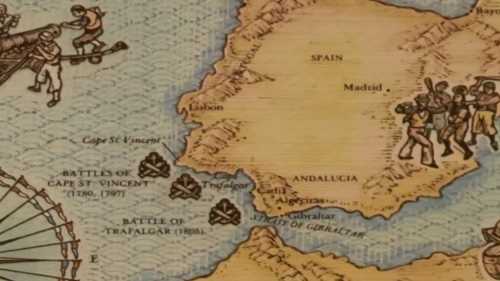
Santa Cruz de Tenerife had a population of about 8000 at the time and was the main trading port of the Canary Islands. It was also the only fortified town, the headquarters of the treasury and the post office, the place of residence of the commander and consular representatives, as well as the only port authorised to trade with America.
The large bay, protected from the prevailing winds by the Anaga Mountains, was an ideal anchorage and refuge for commercial shipping which attracted a large number of corsairs. For this reason the town was supplied with sufficient defences to protect it, and the ships anchored in its waters from attack.
An experienced commander was in charge of its defences, General Antonio Gutiérrez, who had a brilliant military career. Events started in January 1797, when Frigates of the Royal Company of the Philippines carrying valuable goods from the orient, took refuge in the bay of Santa Cruz. In mid-April, one of them was captured under the cover of darkness by two British frigates commanded by Captain Richard Bowen.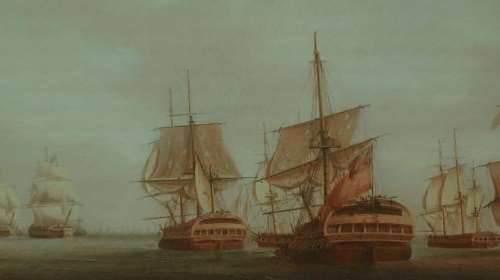
At the end of May events were repeated, when a French corvette was taken in the dark by two British frigates under the command of Captain’s Benjamin Halliwell and George Cockburn. After the success of these attacks, Nelson began to believe that the capture of the town of Santa Cruz would be an easy prize.
On the 14th July 1797, Admiral John Jervis gave the authorisation for the venture, and nine ships of the British squadron with a total of 393 canon set sail for Tenerife. Nelson and his men, chosen from the elite of the royal navy, considered the result of the attack a forgone conclusion.
Nelson’s plan was to land 1000 men to the north of Santa Cruz under the cover of darkness at Valle Seco beach, and proceed immediately to take the fortress of Paso Alto, where there was a battery of 22 canon defending the town making it an extremely important defensive position, and then to attack the town itself.
Nelson sent a letter to the commander of the forces in Santa Cruz, General Antonio Gutiérrez, demanding he surrender his troops and forts, hand over the ship ‘El Principe d’Asturias’ at anchor, the goods on board her and goods already landed.
Nelson offered an honourable surrender, but threatened to bring all the horrors of war upon the inhabitants of Tenerife, destroying Santa Cruz and all the towns on Tenerife by bombardment if his terms were not accepted.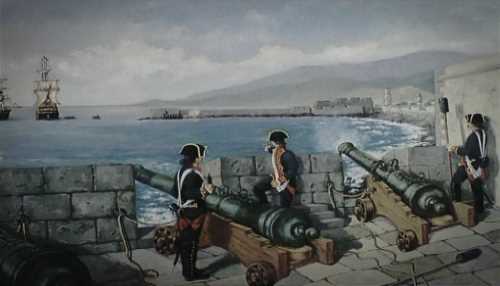
On the 21st July the town was in high state of alert. For its defence it had 84 canon with 375 artillery men spread out from north to south in 17 batteries, forts and castles. The most important forts were the tower of San Andreas, the castle Paso Alto, the fort of San Miguel and the artillery batteries of San Antonio, San Pedro, La Concepcion, San Cristobel and San Juan.
The town had about 1600 men at arms, but only 300 of these could be considered to be professional soldiers, including the infantry battalion of the Canary Islands and a group of French men from a captured corvette.
On the night of the 21st – 22nd July the British frigates had managed to enter the bay of Santa Cruz without being observed, but the unfavourable winds and powerful currents prevented a landing.
A second landing was attempted later on the 22nd July. Nelson had decided to land on a beach beyond the range of the canon of castle Paso Alto, and divided his forces in to three groups, one of which would climb the hills, which according to Nelson’s maps overlooked Paso Alto, and attack the castle from the rear. The remainder of his forces would remain on the lower part of the mountain.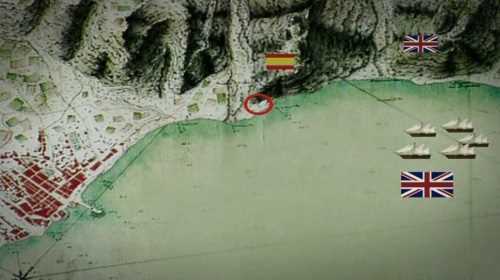
The British landing was completed at midday. Meanwhile the Spanish has guessed the British intensions and has sent two divisions to block their advance, the British were taken completely by surprise. It was at this point that the British realised their maps were wrong, and their advance to Santa Cruz and Paso Alto was blocked by the deep Valle Seco ravine.
When the British saw the Spanish forces they opened fire with their canon and the fire was returned by the Spanish artillery. After the British plan was frustrated, and having held their ground all day, the British had to withdraw that night back to their ships.
Nelson decided that the attack to take Santa Cruz should continue. His plan was to land 960 men, who were fully armed and accompanied by small canon, on to the wharf at the castle San Cristobel and capture the castle from where the Spanish commander was directing the defence. The plan of attack was based on information gathered from a Prussian deserter they had captured on land on the 22nd.
At 5pm on the 24th July the British squadron sailed into the bay at Santa Cruz and anchored at the same place as before. Within two hours, two of the British ships sailed up to the Castle Paso Alto and started a bombardment on it. This was a diversionary tactic to draw the Spanish away from their real intentions.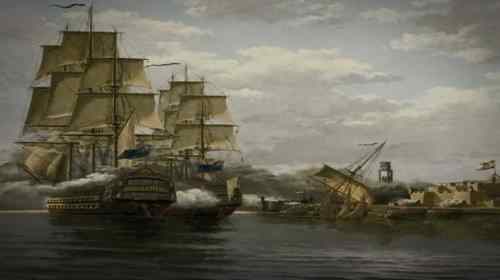
That night at 11pm, 960 men boarded launches from the squadron led personally by Nelson and began to make their way to the shore of the town. They had almost reached the shore when they were spotted by Spanish sentries and the advantage of surprise was lost.
The Spanish batteries opened fire on the launches and ships of the squadron with a heavy bombardment. Due to bad weather and harassment from artillery fire, only five of the launches reached the intended wharf and landed troops. The remainder of the launches headed south, at the same time the cutter HMS Fox was hit and sank with loss of over 90 members of her crew including its commander, Captain John Gibson.
The British landing continued under intense gun fire, but the attackers still managed to put the battery at the end of the pier out of action. At this point Captain Bowen, commander of HMS Terpsichore, was hit and killed.
Rear Admiral Nelson, just as he was stepping on to land on Tenerife with his sword drawn, was hit in his right arm by grapeshot. With his arm shattered and bleeding profusely he was immediately taken to HMS Theseus where his arm was amputated.
The remainder of the British launches, driven by the currents to the south were divided into two groups. The first landed at the beach of La Caleta and headed for the main square, but were held back by fire from the Castle San Cristobel and had to withdraw through the streets to the upper part of the town square. Here they waited for a planned rendezvous with Nelson, but this never happened.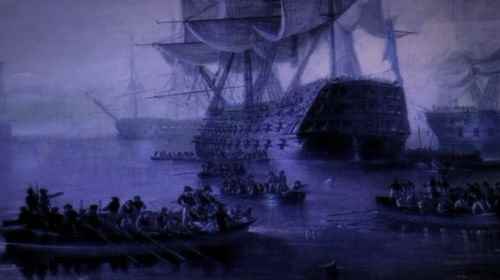
The second group landed on a beach at the mouth of the Santos Ravine, and after being held up by troops from the Canary Islands battalion, withdrew to the surroundings of the monastery of Santo Domingo.
Captain Troubridge at this point decided to try his luck and sent a message to General Gutiérrez demanding his surrender. But he refused this offer replying that he had plenty of gunpowder, bullets and men.
Troubridge and his men withdrew to the monastery and joined forces with the other British soldiers already there and numbered about 600 men. They were surrounded by the islands forces and were expecting relief from the squadron, but the launches sent were forced away from the island and fierce fighting raged all night. Help never arrived.
The British launches used in the landings left on the beach were destroyed by the men, women and children of Santa Cruz. The situation left the British with no options and Captain Hood was sent to offer their surrender to General Gutiérrez, which was accepted.
The British were allowed to leave with their military arms on condition that the squadron agreed not to disturb to town of Santa Cruz or any other of the Canary Islands ever again, to which Troubridge agreed.
By 6am on the 25th July it was all over. The defeated British soldiers paraded in front of the Spanish victors and left on boats given by the islanders to return to their ships. The treatment of the defeated British troops was very generous, the wounded were tended to in the hospital, and they were given all necessary provisions including bread and wine. 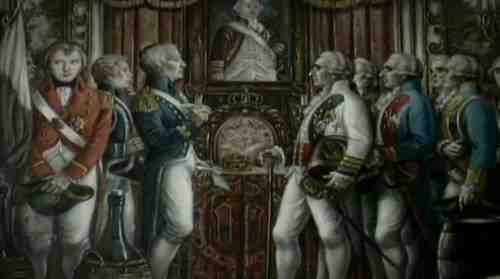
General Gutiérrez invited all the British officers to dinner. The following day, Nelson surprised at this, sent the following letter to General Gutiérrez.
To His Excellency Don Antonio Gutierrez, Commandant-General of the Canary Islands
His Majesty’s Ship Theseus, opposite Santa Cruz de Tenerife.
26th July 1797
Sir,
I cannot take my departure from this island, without returning your Excellency my sincerest thanks for your attention towards me , by your humanity in favour of our wounded men in your power, or under your care, and for your generosity towards all our people who were disembarked, which I shall not fail to represent to my Sovereign, hoping also, at a proper time, to assure your Excellency in person how truly I am, Sir, your most obedient, humble servant,
Horatio Nelson
P.S. - I trust your Excellency will do me the honour to accept a cask of English beer and a cheese.
General Gutiérrez wrote back to Nelson and sent two flagons of the best wine the island had to offer. On 28th July 1797 the British squadron set sail for Cadiz bearing the report in which the minister of war was informed of the victory over the British.
In 1803, King Carlos IV gave the town the title of ‘Very Loyal Noble and Unvanquished Town, Port and Fortification of Santa Cruz de Santiago de Tenerife’, adding a third lions head to the coat of arms which recalls the three victories over the British, Blake in 1557, Jennings in 1706 and Nelson in 1797.
The city of Santa Cruz de Tenerife to this day has the events of July 1797 etched into its culture. Artefacts from the battle, including the canon known as ‘El Tigre’ renowned as firing the shot that injured Nelson, are on display in the Military Museum. The battle is commemorated every year on St James day, when the faded flags from the passing of the years are unfurled.
The defeat at Santa Cruz did not have any adverse effect on Nelsons career, importantly it cured his overconfidence that blurred his judgement in the events leading up to Santa Cruz. And as we all now know the most important part of his career lay ahead in the historic victories of the Nile in 1798, Copenhagen in 1801 and Trafalgar in 1805.
One irony of the defeat is that the city of Santa Cruz named a boulevard, Avenida Horacio Nelson, in honour of the man who had attacked them and not their defender General Gutiérrez.
British Losses
146 dead and 105 wounded
Tenerife Islanders Losses
24 dead and 36 wounded including military men and ordinary islanders
British Airways Return to Tenerife
This week saw the first British Airways flight to Tenerife south for over five years. The BA flight includes a business class service and has been welcomed by the Tenerife authorities. It will encourage wealthier visitors from the UK to Tenerife, which it is hoped will improve the islands reputation as a high class destination which the tourist board on Tenerife are keen to promote.
The BA flight from London Gatwick will operate five times a week, the first flight was sold out months ago and shows there is a demand for a more exclusive service to compete with the low cost, no frills service of the other carriers from the UK.
The new service will appeal to the 4 and 5 star hotel visitors and the higher end of the tourist market.
The BA service includes free seat selection, complimentary food and drinks service, 23kg luggage allowance, no weight restriction on cabin baggage, 34” leg room and use of BA’s exclusive check-in and baggage security scanning areas, making for a quick and hassle free start to your holiday.
There is also the option of upgrading to the business class service. The flights are also operating at a civilised time leaving Gatwick at 1pm and arriving in in Tenerife at 5pm and will operate Monday, Tuesday, Wednesday, Friday and Saturday.
BA and the Tenerife Tourist board have teamed up to promote the island in a marketing campaign to include posters and social media campaigns.
The UK provides Tenerife, the largest of the Canary Islands, with the most tourists every year with 1.5 million visitors.

I Love Music Festival 2013
I Love Music Festival 2013
Friday March 29 · Siam Park Tenerife
The World's Best Water Park, located in Tenerife, welcomes in its 4th edition "I LOVE MUSIC FESTIVAL".
Featuring: Laidback Luke CHUCKIE · · · NVILLA GLOWINTHEDARK Alexei & Carlos Kinn · · Leon Cormack
50th Anniversary of The Beatles in Tenerife
Next month sees the 50th anniversary of the visit to Tenerife by three members the pop group The Beatles. To commemorate the visit there are some events planned in Puerto de la Cruz to celebrate this anniversary. These events start on 27th April and carry on until the 9th May, these dates are exactly 50 years after their visit.
Paul McCartney, George Harrison and Ringo Starr flew to the island on 28th April 1963, the day after they had performed at the Norwich Memorial Hall in England, and stayed until 9th May 1963. This also coincided with the release of their first LP, Please, Please me. John Lennon took his holiday in Barcelona with their manager Brian Epstein.
They travelled with friends Astrid Kirchherr and Klaus Voormann and stayed at the family cottage of the Voorman family in Puerto de la Cruz in the north of the island.
Their fame hadn’t followed them to Tenerife and were unknown at the time to the locals. There is a video of The Beatles in Tenerife from 1963 you can watch.
Dates of various events are shown on the poster below and you can download this itinerary of the Beatles Tenerife celebrations.
You may also enjoy this radio broadcast clip from the McIntyreinthemorning on SoundCloud radio.
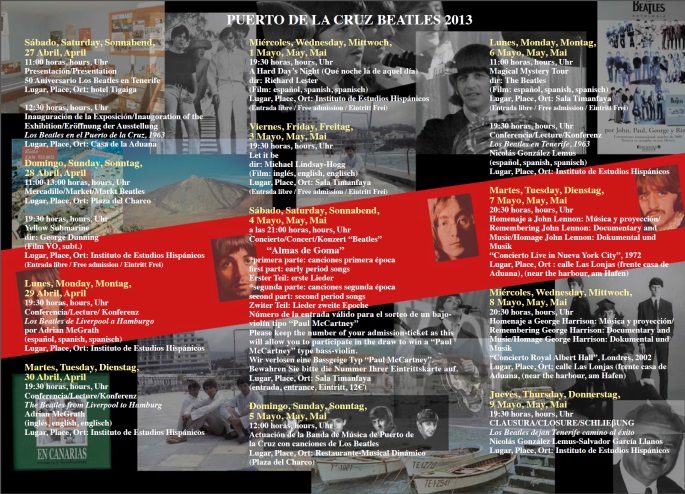

{gallery}http://www.flickr.com/photos/etenerifeholidays/sets/72157633111486374/{/gallery}
Costa San Miguel Carnaval 2013
There is another carnival on Tenerife coming up, the Costa San Miguel Carnaval in Golf del Sur. This one starts at 5pm by the San Blas commecial centre goes down the Calle San Miguel, ending at the Aguamarina Hotel.

